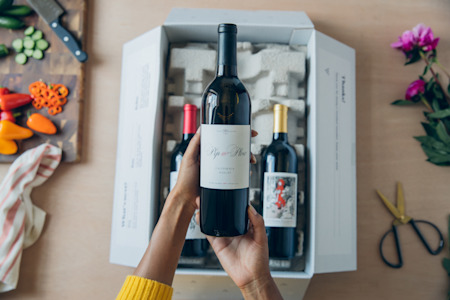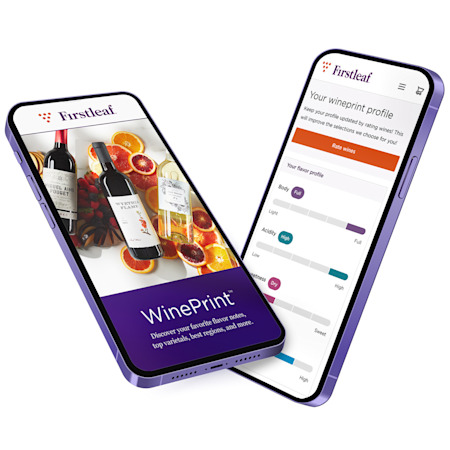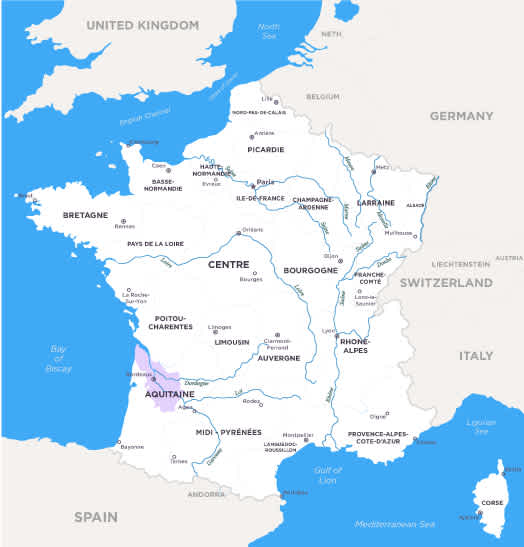Bordeaux
Bordeaux produces the most recognizable and most sought after wines on the planet
Bordeaux is arguably the most important and enduring wine region in the world. It's located in southwestern France, where the Garonne and Dordogne rivers turn into the Gironde estuary. The region boasts around 275,000 acres of vineyards and 65 appellations, making everything from everyday drinking wines to the most sought-after, high-end bottlings of the wine world.
It's the latter people typically think of when there's talk of Bordeaux wine: age-worthy reds made from Cabernet Sauvignon, Merlot and Cabernet Franc, a blend that has been emulated by many of the world's best wine regions. These wines display a mix of black and blue fruit, often complemented by earth, mineral, and herbal accents, depending on which Appellation d'Origine Contrôlée (AOC) they hail from. They are generally medium- to full-bodied, with medium to high alcohol and structured tannins. The best are very long-lived and can age for decades. They can also set you back several hundred dollars.
However, the vast majority of wines made in Bordeaux are affordable and easy-drinking, including fruity reds, whites, rosés and even sparkling wines. Here's your guide to Bordeaux's storied past, what to expect from the wines today, and the main grape varieties and regions to know.

Take Our Quiz Today
Get award-winning delicious wines from all over the world shipped straight to your door. Take the quiz to get the perfect pairings for your holiday season.
Take The Quiz TodayIN THIS ARTICLE:
Want personalized wines?
Get your first box of wines for $44.95 + free shipping.

History of Bordeaux
While the first vineyards in Bordeaux were likely planted by the Romans, it wasn't until about the 12th century A.D. that the region developed into the behemoth that it is today. At the time, Bordeaux was ruled by the English, who shipped the wines back home and to international markets. (You may have heard red Bordeaux wines being referred to as "claret"—the English invented that term). When the French took Bordeaux back in the 1450s, the wine trade continued and formalized, creating a business model whose legacy endures today. Château owners cultivated the land and made the wine, then sold it shortly after harvest to négociants (merchants), who aged, bottled and then brought the wine to market.
In the 19th century, French emperor Napoléon III took note of Bordeaux wine's success and commissioned a classification for the Paris Exposition of 1855. Châteaux would be ranked by the price of their wine, from highest to lowest. This list is now known as the famous 1855 classification, which ranked Médoc châteaux in five tiers, from first growth to fifth growth. There were originally four premiers crus: Château Haut-Brion, Château Lafite Rothschild, Château Latour, and Château Margaux. Only one change was ever made to the classification: In 1973, Château Mouton-Rothschild was promoted to first growth. And then there were five.
What to Expect from Bordeaux Wine Today
More than a century and a half later, the 1855 classification still stands as the hierarchical gold standard. Many of the top châteaux have maintained a similar level of quality; however, some have arguably surpassed their rank, while others are far from their glory days. The 1855 classification is still a relatively good guide to quality today, but keep in mind that it is based on the château and not on the actual terroir, like the system in Burgundy, for example. This means that if a second growth château owner buys land and uses it for their wine, those new vineyards are technically considered second growth as well, even if they weren't before the purchase.
Regardless, Bordeaux remains the most important wine region in France. Négociants still exist today but have a different role, mostly sticking to sales; château owners largely take care of aging and bottling. The modern system of Bordeaux wine sold through négociants is called the place de Bordeaux, and it operates a little differently from other wine regions. Every year there is an event called en primeur, where consumers can buy Bordeaux wines as "futures" before they are actually released. This supposedly gives shoppers good deals, as opposed to paying for the wines upon release once their prices have appreciated, but it can be a gamble.
Every château makes a grand vin, which is the top of the range, made with the best fruit. Many châteaux now make second and even third wines, offering cheaper bottlings to buyers who want a taste of what the property has to offer. For example, Le Petit Mouton is Mouton-Rothschild's second wine, Pavillon Rouge is Margaux's second wine, Les Forts de Latour is Latour's second wine, Le Clarence and La Clarté are Haut-Brion's second and third wines, and so on.
Grape Varieties in Bordeaux
Red Bordeaux Grapes:
Red Bordeaux wine is almost always a blend. The main red grapes used are Cabernet Sauvignon, Merlot and Cabernet Franc.
Cabernet Sauvignon is perhaps the best-known grape, and is the main component of Left Bank wines, like Pauillac, Margaux and Pessac-Léognan. It has thick skins, which result in hefty tannins in the final wines, and shows ripe black fruit notes, such as blackcurrant, blackberry and plum, with additional details of licorice, tobacco, spice and minerals.
Merlot, the second most important variety in Bordeaux, brings fruitiness to the blends, displaying a mix of plum, blackberry, raspberry and cherry, as well as spice and aromatic notes like cinnamon and black tea. Merlot also has much more supple tannins than Cabernet Sauvignon. It makes up the majority of Right Bank blends, like Pomerol and St.-Emilion.
Cabernet Franc is Merlot's righthand grape in Right Bank blends, but can also be found in Left Bank blends, most often as a third wheel. Like Merlot, it also has relatively supple tannins and plush black and red fruit, but its signature herbal notes are what sets it apart.
Three other grape varieties are allowed in Bordeaux blends by appellation law, but have fallen out of favor in modern times and are not widely used. They are Petit Verdot, Malbec, and Carmenère. While the first two are not completely uncommon, the latter is extremely rare in Bordeaux nowadays, but it has found a home in Chile.
White Bordeaux Grapes:
Yes, the Bordeaux region also makes white wines, and they are worth seeking out. Dry whites are typically a blend of Sauvignon Blanc, Sémillon and, to a lesser extent, Muscadelle. Some winemakers make 100% Sauvignon Blancs, and every now and then, you'll find an example with Sauvignon Gris.
Sauvignon Blanc brings the high acidity to white blends, as well as the citrus and herbal notes—think lemon, lime, gooseberry and lemongrass. Sémillon rounds out the blend's sharp edges with its plush texture and fruit, like peach and apricot. Entre-Deux-Mers, Graves and the generic Bordeaux AOC are the most common appellations for dry white Bordeaux; Pessac-Léognan whites are the most reputable.
The same white grapes make up sweet wines blends, but these are left on the vine much longer and develop a type of noble rot called Botrytis cinerea. This fungus shrivels the berries, concentrating the juices and sugars. The most lauded dessert wines in the world come from Bordeaux, such as Sauternes and Barsac.
Bordeaux Wine Regions
As the most prestigious winegrowing region in France, Bordeaux puts a lot of weight on its various appellations, which each reflect their own terroir. Roughly, the area is divided along the river into the Left Bank and the Right Bank. Generally speaking, Left Bank reds rely on Cabernet Sauvignon first, then Merlot, then Cabernet Franc; Right Bank reds lead with Merlot, then Cabernet Franc, with very little Cabernet Sauvignon. Whites, dry and sweet, blend Sauvignon Blanc and Sémillon, with lesser proportions of Muscadelle. Here are the main subregions and AOCs you should know about.
Left Bank Bordeaux
Médoc:
This part of the Left Bank is the cream of the crop of Bordeaux wine and counts four renowned appellations, all producing red wines, where the large majority of the classified crus are located.
Starting in the north, St.-Estèphe has five classified growths. The AOC has the Médoc's signature gravel soils close to the Gironde estuary, where Cabernet Sauvignon thrives, and more clay farther inland, where Merlot does best. St.-Estèphe wines tend to be a little more austere and less approachable in their youth than the rest of the top Médoc reds.
Moving south, we have Pauillac, which is by far the most esteemed appellation in all of Bordeaux. This is where three of the five first growths are located: Châteaux Lafite Rothschild, Latour and Mouton-Rothschild. Pauillac has 18 total classified growths. The appellation has a mix of gravel and sandy soils. These red wines are very ageworthy and show ripe blackcurrant flavors and pronounced minerality.
Then we have St.-Julien, which has 11 classified growths. The appellation has diverse soils, from gravel to sand to clay, and makes red wines that are just as ageworthy and structured as Pauillac, but tend to be a little more refined and approachable.
The farthest south, Margaux has 21 classified growths and one first growth, Château Margaux. Its soils are a mix of gravel and sand, with very little clay compared to its Médoc counterparts. This results in elegant wines with more finesse and fragrant aromas and flavors.
Other appellations here, considered of lesser quality but good values, include Haut-Médoc, Médoc, Listrac and Moulis.
Graves:
The Graves region is still on the Left Bank, but farther south of the Médoc and the city of Bordeaux. While red wines are also made here, white wine is equally as important. This is due to the limestone and sand soils that are found here in addition to the gravel.
Pessac-Léognan is the most prestigious appellation here, home to first growth Château Haut-Brion. This pocket was actually just called Graves until 1987, when it was recognized as deserving of its own AOC. There is a little more gravel here than other parts of the Graves. The best reds rival those of the Médoc, but they are slightly more earthy and rustic. Pessac-Léognan's dry whites, however, reign supreme in the category. Château Haut-Brion's white, for example, costs twice as much as its red.
Graves is the name of the overall region but is also its own catchall AOC. Winemakers here make both reds and whites, which are typically more straightforward and easy-drinking than Pessac-Léognan bottlings.
The Graves region is also where the majority of sweet whites is made. It's all about the terroir: The Ciron River creates a mist that encourages the growth of Botrytis. Sauternes is the most renowned appellation, making rich sweet wines from Sauvignon Blanc, Sémillon and Muscadelle, like the famous Château d'Yquem. Barsac wines are also worth seeking out, yet are slightly less opulent than Sauternes because the area has more limestone in its soils.
Other sweet whites of the Graves include Cadillac, Cérons, Loupiac and Ste.-Croix du Mont, which all carry a lower price tag than Sauternes and Barsac.
Right Bank Bordeaux
St.-Emilion:
St.-Emilion is large and varied in its terroirs. Despite its importance today, it was not included in the 1855 classification. However, the appellation established a classification of its own in the 1950s, dividing worthy châteaux into four categories: Grand Cru, Grand Cru Classé, Premier Grand Cru Classé B and Premier Grand Cru Classé A. The latter is the highest rank and includes four châteaux: Château Angélus, Château Ausone, Château Cheval-Blanc and Château Pavie. Unlike the 1855 classification, the St.-Emilion rankings are revised every 10 years.
Quality in St.-Emilion wines is, generally speaking, dependent on where in the appellation the vineyards lie. There are vast, flat areas with predominantly sandy soils that make decent quality St.-Emilion. The higher plateaus, with more limestone soils, produce the most well-regarded bottlings.
Pomerol:
Pomerol has a mix of soils, including gravel, sand and clay. It is a fraction of the size of St.-Emilion but has a lot of clout, notably because the appellation is home to such legends as Pétrus and Le Pin. A special type of clay, in which the best vineyards are located, distinguishes Pomerol from its neighbors.
Other Right Bank Appellations:
The two top AOCs of the Right Bank have what are called "satellite" appellations: Montagne-St.-Emilion, Lussac-St.-Emilion, Puisseguin-St.-Emilion, St.-Georges-St.-Emilion and Lalande-de-Pomerol. They all make red wines.
Fronsac and Canon-Fronsac provide great quality reds at reasonable prices. The former has clay-limestone soils, while the latter is mostly limestone.
A group of winemakers from small appellations on the Right Bank decided to band together in 2009 under the moniker Côtes de Bordeaux. Each area—Blaye, Cadillac, Castillon, and Francs—uses its name as a prefix to the broader AOC. Côtes de Bourg was the only holdout. They all make red wines; Blaye and Francs also make white wines.
Other Bordeaux Wine Regions
Of course, there is the generic Bordeaux AOC, which is used for wines that hail from areas that are not contained in another more specific appellation. It is also used if a wine falls under an appellation geographically but does not follow certain winemaking restrictions to be labeled as such.
The best example of this is white Bordeaux. For example, if winemakers make white wine from vineyards in Pomerol or Pauillac, it will be labeled as a Bordeaux AOC. Bordeaux rosé is also labeled as just Bordeaux, and sparkling wines are called Crémant de Bordeaux.
Bordeaux Supérieur has stricter requirements than Bordeaux AOC: They must be red or white, and have a higher minimum alcohol content and lower yield maximums.
Entre-Deux-Mers, located between the Garonne and Dordogne rivers, makes exclusively dry white wines. It's the only appellation in Bordeaux to have this sole focus.
IN THIS ARTICLE
Want personalized wines?
Get your first box of wines for $44.95 + free shipping.


WinePrint™ by Firstleaf
Are you looking to learn more about your wine preferences? Check out our Wine Print for an in-depth look at your personal tasting profile. Discover your favorite wines, varietals, regions, and tasting notes and get personalized recommendations wherever you are.
Learn More
